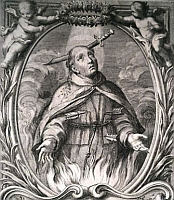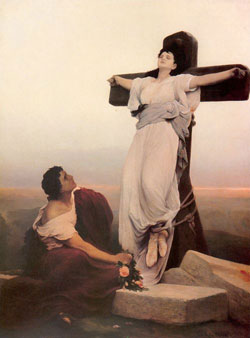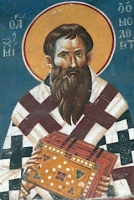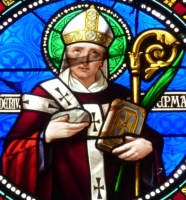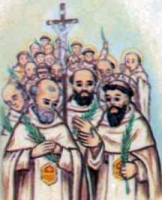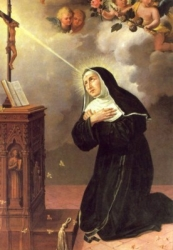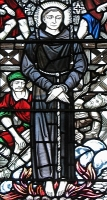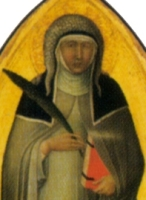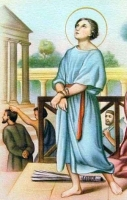Madonna Della Strada
“மடோன்னா டெல்லா ஸ்ட்ரடா” (Madonna Della Strada), “ஸான்டா மரியா டெல்லா ஸ்ட்ரடா” (Santa Maria Della Strada), “பாதையோர அன்னை” (Our Lady of the Way) மற்றும் “சாலையோர மாதா” (Our Lady of the Road) என்ற பெயர்களிலெல்லாம் அழைக்கப்படும் மரியன்னையின் ஒரு திருச்சொரூப படம் ரோம் நகரிலுள்ள “கேசு தேவாலயத்தில்” (Church of the Gesu in Rome) போற்றிப் பாதுகாக்கப்படுகின்றது. இத்தேவாலயம், இயேசு சபையினரின் “தாய் தேவாலயம்” (Mother Church of the Society of Jesus) என்று அறியப்படுகின்றது.
“சாலையோர மாதா” இயேசு சபையினரின் பாதுகாவலியாவார்.
மாதாவின் மீது இயேசு சபையினருக்கு என்றுமே ஒரு தனி பக்தி உண்டு. இவ்வாலயம் இயேசு சபையின் முதல் ஆலயம் ஆகும். இவ்வாலயத்தை மையமாக வைத்தே புனித இஞ்ஞாசியாரும், அவர் தம் தோழர்களும் தங்களது ஆன்மீக பணிகளில் ஈடுபட்டனர். இவ்வாலயத்தில் மன்றாடிவிட்டு சென்றபோது செய்த காரியங்கள் அனைத்துமே வெற்றி பெற்றது. இதனால் இந்த சிற்றாலயத்திற்கு இன்று வரை தனிச்சிறப்பு உள்ளது.
கி.பி. 1538ம் ஆண்டின் இறுதியில் புனித இனிகோ தம் தோழர்களுடன் இந்த ஆலயத்திற்கு அருகில் கிடைத்த ஓர் வீட்டில் தங்கிருந்து தங்களின் பணிகளில் ஈடுபட்டனர். இந்த ஆலயத்தில் அடிக்கடி திருப்பலி நிறைவேற்றுவது, மறையுரை ஆற்றுவது, ஒப்புரவு அருட்சாதனம் அளிப்பது, மறைக்கல்வி போதிப்பது என பல பணிகள் இவர்களின் முதன்மை பணிகளாக அமைந்தது. அவ்வாலயத்தின் பங்குத்தந்தையாக இருந்த பீட்டர் கொடாசியோவுக்கு (Peter Codasio) இயேசு சபையினர் ஆற்றிய பணிகள் மிகவும் பிடித்திருந்தது. அப்போது கி.பி. 1538ம் ஆண்டு டிசம்பர் மாதம் முதல், 1539 மே மாதம் வரை ரோமிலும், சுற்றுவட்டாரங்களிலும் கடுங்குளிரும், உணவுப் பற்றாக்குறையும் மக்களை வாட்டி வதைத்தது. புனிதர் இனிகோ தம் சகோதரர்களுடன் 3000 மக்களின் துயர் நீக்கி, உணவும், உடையும் கொடுத்து வந்தார். இத்தொண்டு பங்கு குரு பீட்டர் கொடாசியோவின் நெஞ்சை நெகிழ வைத்தது. அவர்களின் தொண்டால் பங்கு குரு பெரிதும் ஈர்க்கப்பட்டார். இதனால் அச்சபையில் சேரவிரும்பி, ஒருமாத தியானத்தில் ஈடுபட்டு, இறுதியில் கி.பி. 1539ம் ஆண்டு, இயேசு சபையில் சேர்ந்தார். இவர்தான் இயேசு சபையின் முதல் இத்தாலியர் ஆவார். அதன்பின் இவர் வழியாக சட்டரீதியாக சாலையோர மாதா ஆலயம் இயேசு சபைக்கு கிடைத்தது.
இந்த ஆலயம் மிகவும் சிறியதாகவும், குறுகலாகவும் இருந்ததால் பல மக்கள், பல ஆண்டுகளாக, ஆலயத்தின் வெளியே நின்றவாறே திருப்பலியில் பங்குக்கொண்டனர். இதனால் இயேசு சபையினர் அனைவரின் உழைப்பால் இவ்வாலயத்தின் முன்னால் திருப்பலிக்கென்று இடம் ஏற்பாடு செய்யப்பட்டது. பின்னர் இயேசு சபையினர், தங்குவதற்கும், பணிபுரிவதற்கும் வசதியாக தந்தை பீட்டர் தம் தந்தையின் சொத்துக்களை விற்றுப்பெரிய வீடு ஒன்றை அமைத்து கொடுத்தார். அச்சமயத்தில் இயேசு சபையில் இறந்தவர்கள் இவ்வாலயத்தில்தான் அடக்கம் செய்யப்பட்டார்கள். புனித பீட்டர், இவரின் தந்தை கொடாசியோ, புனித இனிகோ அனைவரும் இவ்வாலயத்தில் தான் அடக்கம் செய்யப்பட்டார்கள்.
இவர்களின் இறப்பிற்கு பின் கி.பி. 1565-ல் பிரான்சிஸ் போர்ஜியா (Francis Borgiya) என்பவர் இயேசு சபையின் தலைவராக பொறுப்பேற்றார். இவரது காலத்தில் ஜேசு என்ற பெயரில் பேராலயம் ஒன்று கட்டுவதற்காக முன்னிருந்த சிற்றாலயத்தை இடித்துவிட்டு, இன்று ஜேசு என்றழைக்கப்படும் பேராலயத்தைக் கட்டினார். இவ்வாலயம் ரோம் நகரில் உள்ள ஆலயங்களில் மிகவும் கவர்ச்சிகரமானமாக காணப்படுகின்றது. இன்றுவரை உலகின் எப்பகுதியிலிருந்தும் இயேசு சபை குருக்கள் ரோம் வந்தாலும் இவ்வாலயத்தில், சிற்றாலயத்திலிருந்து கொண்டுவரப்பட்ட மாதா திருச்சொரூபத்தின் முன், திருப்பலி நிறைவேற்றுவதில் தனி ஆர்வம் காட்டுகின்றனர்.
Madonna Della Strada or Santa Maria Della Strada (English: Our Lady of the Wayside or Saint Mary of the Good Road) is a painting of the Blessed Virgin Mary enshrined at the Church of the Gesù in Rome, mother church of the Society of Jesus (Jesuits) religious order of the Catholic Church; it is a variation on the basilissa (imperial) type of icon.[1]
The Madonna Della Strada is the patron saint of the Society of Jesus. The society's founder, Ignatius of Loyola, was said to have been protected by the intercession of the Blessed Virgin Mary during battle in his service as a soldier.[2]
History
The name goes back to a shrine established in Rome in the 5th century by the Astalli family, originally known as the Madonna degli Astalli, at a crossroads along the ceremonial route of the popes.[1] The 13th-14th century fresco[3] (a wall painting done on damp plaster) was originally painted on the wall of Saint Mary of the Way in Rome, the church of the Society of Jesus (Jesuits), given to Saint Ignatius by Pope Paul III in 1540.[3]
In 1568, Cardinal Alessandro Farnese erected the Gesù Church of Rome, the mother church of the Jesuits, in place of the former church of Santa Maria della Strada. The fresco was moved there in 1575 to a side chapel where Jesuits pronounced their vows. Sometime in the 19th century, the image was transferred to canvas and affixed to a slate panel.[1]
Pope Urban VIII granted a decree of Canonical Coronation towards the image. The coronation took place on August 14, 1638
The icon is located between two altars, the first dedicated to Ignatius of Loyola, the second, the main altar of the Church, dedicated to the Holy Name of Jesus.[4]
The icon was restored in 2006, revealing at least two layers of previous paint, the original art being a fresco which had been detached from a wall and affixed to canvas.[5]
Legacy
The Jesuits celebrate the feast of Our Lady of the Way on May 24.[6]
There is a chapel dedicated to Madonna Della Strada at Loyola University in Chicago, Illinois,[7] at the University of Scranton in Scranton, Pennsylvania,[8] and at Zilber Hall, Marquette University in Milwaukee, Wisconsin.[9]
The Madonna della Strada Chapel is located at the campus ministry center of Le Moyne College.[10]
The Society of the Lady of the Way is a secular institute in Vienna, Austria that follows the spirituality of St Ignatius of Loyola
Our Lady, Help of Christians
கிறிஸ்தவர்களின் சகாய அன்னை
சலேசியர்களின் பாதுகாவலி:
திருவிழா நாள்: மே 24
"கிறிஸ்தவர்களின் சகாய அன்னை" (Our Lady Help of Christians) என்பது, ரோமன் கத்தோலிக்க திருச்சபையில் கொண்டாடப்படும் அன்னை மரியாளின் பக்தியாகும். இத்திருவிழா, மே மாதம், 24ம் நாளன்று, கொண்டாடப்படும் ஒரு திருவிழா ஆகும்.
கி.பி. 345ம் ஆண்டில், அன்னை கன்னி மரியாளுக்கான பக்தியாக இந்த மரியான் பட்டத்தை முதன்முதலில் பயன்படுத்தியவர் புனிதர் ஜான் கிறிஸோஸ்டம் (Saint John Chrysostom) ஆவார். இந்த தலைப்பில் மரியான் பக்தியை பரப்புவதில் சிறப்பான பங்காற்றியவர், புனிதர் டான் போஸ்கோ (St. Don Bosco) ஆவார். "கிறிஸ்தவர்களின் சகாய அன்னை" (Our Lady Help of Christians) என்ற தலைப்பு, கிறிஸ்தவ ஐரோப்பா (லத்தீன் மற்றும் கிரேக்கம்), ஆப்பிரிக்காவின் வடக்கு மற்றும் மத்திய கிழக்கு ஆகியவற்றை, இடைக்காலத்தில் கிறிஸ்தவமல்லாத பிற இன மக்களிடமிருந்து பாதுகாப்பதில் தொடர்புடையது ஆகும்.
இஸ்லாமிய ஒட்டோமான் பேரரசின் (Islamic Ottoman Empire) விரிவாக்கத்தின்போது, கிறிஸ்தவ ஐரோப்பாவை அவர்கள் ஆக்கிரமிக்கும் வேளையில், திருத்தந்தை ஐந்தாம் பயஸ், (Pope Pius V) கிறிஸ்தவப் படையினரை உதவிக்கு அழைத்தார். ஐரோப்பா முழுவதிலும் உள்ள கத்தோலிக்கர்கள் ஜெபமாலை ஜெபித்தபோது கிறிஸ்தவமண்டலம் முழுவதும் கிறிஸ்தவர்களின் சகாய அன்னை மரியாளின் உதவியால் காப்பாற்றப்பட்டது. கி.பி. 1571ம் ஆண்டு, அக்டோபர் மாதம், 7ம் தேதி, லெபாண்டோவின் பெரும் போர் (Great Battle of Lepanto) நிகழ்ந்தது.
மேலும், இப்போரின் வெற்றியின் விளைவு, இந்த தலைப்பின் கீழே, மரியாளின் பரிந்துரையே காரணம் என நம்பப்படுகிறது. இறுதியில், இஸ்லாமியம் மீது கிறிஸ்தவத்தின் தீர்க்கமான வெற்றிக்கு நன்றி செலுத்துவதற்காக கி.பி. 1903ம் ஆண்டு, மே மாதம், 17ம் நாளன்று, திருத்தந்தை பதின்மூன்றாம் லியோ (Pope Leo XIII) இவ்விழாவினை ஏற்படுத்தி, மரியன்னையின் திருவுருவத்திற்கு "கிறிஸ்தவர்களின் சகாய அன்னை" எனும் பெயர் பொறிக்கப்பட்ட பட்டத்தினை முடிசூட்டினார். இது, தற்போது "கிறிஸ்தவர்களின் சகாய அன்னை பேராலயத்தில்" (Basilica of Mary Help of Christians) நிரந்தரமாக பொறிக்கப்பட்டுள்ளது.
புனிதர் ஜான் போஸ்கோவும், கிறிஸ்தவர்களின் சகாய அன்னையும்:
புனிதர் ஜான் போஸ்கோ, ஒரு சக்தி வாய்ந்த கத்தோலிக்க குரு ஆவார். இவர், கி.பி. பத்தொன்பதாம் நூற்றாண்டில் இத்தாலி நாட்டில், தமது சலேசியன் சபையை (Salesian Order) நிறுவினார். அவரது பல தீர்க்கதரிசன கனவுகள், ஒன்பது வயதில் தொடங்கி, அவருடைய ஊழியத்திற்கு வழிகாட்டின. எதிர்கால நிகழ்வுகள் பற்றிய நுண்ணறிவுகளையும் அளித்தன.
கி.பி. 1862ம் ஆண்டு, மே மாதம், 14ம் நாளன்று, திருச்சபையானது, பிந்தைய நாட்களில் எதிர்கொள்ளவிருக்கும் போர்களைப் பற்றி ஜான் போஸ்கோ கனவு கண்டார். அந்த காலத்தைய திருத்தந்தை, இரண்டு தூண்களுக்கு இடையில் திருச்சபையின் 'கப்பலை' நங்கூரமிடுவதாகவும் கனவு கண்டார். ஒன்று தூண், கிறிஸ்தவர்களின் சகாய அன்னையின் சொரூபம் என்றும், மற்றொன்று பெரியதொரு நற்கருணை என்றும் அவருக்கு காட்சியளித்தது.
ஜான் போஸ்கோ, தமது சலேசிய சபையினைப் பற்றி எழுதுகையில், "நற்கருணை பக்தியை பரப்புவதும், கிறிஸ்தவர்களின் சகாய அன்னையின் பக்தியை பரப்புவதுமே இச்சபையின் பிரதான நோக்கமாகும்" என்று எழுதினார். மேலும், "'கிறிஸ்தவர்களின் சகாய அன்னை' எனும் இத்தலைப்பானது, ஆகஸ்ட் விண்ணரசியை மிகவும் மகிழ்விக்கும்" என்று எழுதினர்.
Also known as
Auxilium Christianorum
Profile
The feast of Our Lady, Help of Christians, was instituted by Pope Pius VII. By order of Napoleon, the Pope was arrested on 5 July 1808, and imprisoned at Savona, Italy and Fontainebleau, France. In January 1814, after the Battle of Leipzig, he was brought back to Savona and set free on 17 March, the eve of the feast of Our Lady of Mercy, the patroness of Savona. The journey to Rome was a veritable triumphal march with the pontiff, attributing the victory of the Church after so much agony and distress, to the Blessed Virgin. He visited many of her sanctuaries on the way, crowning her images, and entered Rome on 24 May 1814 to enthusiastic crowds. To commemorate his own sufferings and those of the Church during his exile he extended the feast of the Seven Dolours of Mary to the universal Church on 18 September 1814.
When Napoleon left Elba and returned to Paris, Murat was about to march through the Papal States from Naples. Pius VII fled to Savona on 22 March 1815, where he crowned the image of Our Lady of Mercy on 10 May 1815. Following the Congress of Vienna and Battle of Waterloo, he returned to Rome on 7 July 1815. To give thanks to God and Our Lady, he instituted the feast of Our Lady, Help of Christians for the Papal States on 15 September 1815; it was celebrated on 24 May, the anniversary of his first return. The dioceses in the Tuscany region adopted it on 12 February 1816, and it spread over nearly the entire Latin Church.
They hymns of the Office were composed by Brandimarte. It is the patronal feast of Australasia, a double of the first class with an octave, and is celebrated with great splendour in the churches of the Fathers of the Foreign Missions of Paris. It has attained special celebrity since Saint John Bosco dedicated the mother church of his congregation at Turin to Our Lady, Help of Christians. The Salesian Fathers have carried the devotion to their numerous establishments, and prayers for her intervention are credited with the miraculous cure of Blessed Artemide Zatti.
Patronage
• Australia (proclaimed on 17 July 1916 by Pope Benedict XV)
• New Zealand
• Andorran security forces
• Austrialian military chaplains
• New York
• diocese of Shrewsbury, England
• diocese of Townsville, Australia
Blessed Maria Gargani
Also known as
• Maria Crocifissa del Divino Amore
• Maria Crocifissa of Divine Love
Profile
Youngest of eight children born to Rocco Gargani and Angiolina De Paola. Hers was a pious family, and her father made sure the children learned their faith. Educated in Morra de Sanctis and Avellino in Italy, and earned a master's degree in 1913. School teacher in San Marco la Catola, Foggia, Italy from 1913 to 1928. Feeling a call to religious life, she joined the Secular Franciscan Order in 1914, and developed a deep devotion to Saint Francis of Assisi. She taught catechism to children, and helped them prepare for First Communion. She even purchased a projector, a great novelty at the time, to display images to explain the life of Christ. Member of Catholic Action In August 1916 she became the spiritual student of Saint Padre Pio; he was not only her spiritual director but they became friends and correspondents for over 50 years. Taught in Volturara Appula, Italy from 1928 to 1945. In 1934 she received diocesan permission to form a new congregation of women based at the former convent of Santa Maria della Sanità. These women became the core of the Sisters Apostles of the Sacred Heart, founded on 11 February 1936. The Sisters moved to Naples, Italy in early 1945, and on 18 April 1945 they made their profession; Blessed Maria took the name Sister Maria Crocifissa of Divine Love. From 1946 until her retirement, Sister Maria taught in Naples and worked to spread the work of the Sisters. Pope John XXIII gave the Sisters full pontifical approval on 12 March 1963, and they continue their good work today.
Born
evening of 23 December 1892 at Morra de Sanctis, Avellino, Italy
Died
• 23 May 1973 in Naples, Italy of natural causes
• re-interred at the motherhouse of the Sisters Apostles of the Sacred Heart on 17 May 1992
Beatified
• 2 June 2018 by Pope Francis
• the beatification miracle involved the 1975 healing of Michelina Formichella of Torrecuso, Benevento, Italy
• beatification recognition celebrated at the cathedral of Naples, Italy presided by Cardinal Angelo Amato
Patronage
Sisters Apostles of the Sacred Heart
Martyrs of the Small West Gate
Additional Memorial
20 September as part of the Martyrs of Korea
Profile
A group of lay catechists and catechumens who were imprisoned and executed together for the crime of being Christian.
• Saint Agatha Kim A-Gi
• Saint Agatha Yi So-Sa
• Saint Anna Pak A-Gi
• Saint Augustine Yi Kwang-Hon
• Saint Barbara Han A-Gi
• Saint Damianus Nam Myong-Hyok
• Saint Lucia Pak Hui-Sun
• Saint Magdalena Kim Ob-I
• Saint Petrus Kwon Tug-In
Died
beheaded on24 May 1839 at the Small West Gate, Seoul, South Korea
Canonized
6 May 1984 by Pope John Paul II
Saint Simeon Stylites the Younger
Profile
Son of Saint Marthe. Simeon's father died when the boy was five years old, and he became the ward of a monk named John who lived nearby. When Simeon was seven, the two moved onto platforms at the top of pillars in order to ensure their solitude. Word spread about the sanctity and wisdom of the pair; they attracted so many pilgrims and would-be disciples that at age 20, Simeon came down from his pillar to hide in the mountains. Ten years later there were more would-be students, and this time Simeon decided to help them; he built a monastery for them, and in it placed a pillar for himself. Ordained at age 35; the bishop climbed onto the platform to impose his hands. Simeon celebrated Mass on his platform, and the monks climbed a ladder to receive Communion. Healer and miracle worker, he spent 69 of his 76 years living off the ground.
Born
521 at Antioch
Died
597 of natural causes
Saint David of Scotland
Profile
Youngest son of King Malcolm III Canmore and Saint Margaret of Scotland; brother of Saint Matilde in whose court he grew up and was educated. Prince of Cumbria in 1107. Married. Ascended to the throne of Scotland in 1124. Fought in the border wars with England, and in 1138 participated in the armistice that halted the fighting. Devoting himself to the welfare of his people, he re-organized the system of land ownership and implemented both new laws and a new legal system. Worked to bring the faithful in Scotland closer to the Vatican, founded convents and monasteries, supported monastic work and the organization of five new dioceses. Spiritual student of Saint Aelredo of Rievaulx.
Born
1085
Died
• 24 May 1183 in Carlisle, Scotland of natural causes
• buried in Dunfermline Abbey
Saint Joanna the Myrrhbearer
Profile
First century lay woman. Married to Chusa, steward of King Herod Antipas. Disciple of Jesus, and mentioned in Luke (8:3) as providing for Jesus and the Apostles. Eastern tradition says that she gave the head of John the Baptist an honourable burial. One of the women Luke says (24.10) discovered the empty tomb on the first Easter when she went to anoint the body, and celebrated on the 3rd Sunday of Pascha in the Orthodox Church as the Myrrh-bearers. She is especially venerated by the Jesuits.
Representation
• ointment box
• woman carrying an ointment box
• woman with a cross in her arms and a lamb standing nearby
• woman carrying a pitcher in a basket
• woman standing with her husband among court ladies hearing Jesus preach
Blessed Louis-Zéphirin Moreau
Profile
Born to a farm family, he was a sickly youth. Taught philosophy at the seminary at Nicolet, Quebec, Canada. Ordained on 19 December 1846. Secretary to a series of bishops of Saint-Hyacinthe, Quebec. Founded the Union of Saint Joseph in 1874. Bishop of Saint-Hyacinthe on 19 November 1875. Founder of the Sisters of Saint-Joseph of Saint-Hyacinthe in 1877, and the Sisters of Sainte-Martha.
Born
1 April 1824 in Bécancour, Quebec, Canada
Died
24 May 1901 in Saint-Hyacinthe, Quebec, Canada
Beatified
10 May 1987 by Pope John Paul II
Patronage
diocese of Saint-Hyacinthe, Québec
Blessed John del Prado
Also known as
• Giovanni di Prado
• John of Prado
Profile
Studied theology at Salamanca, Spain. Priest. Member of the Barefooted Franciscans of the Strict Observance. Missionary to Muslims in Morocco in 1613. Imprisoned, tortured and martyred by order of the ruler of Marrakesh with two other Spanish friars whose names have not come down to us.
Born
at Morgobresio, Kingdom of Léon, Spain
Died
burned to death on 24 May 1636 at Morocco
Beatified
24 May 1728 by Pope Benedict XIII
Blessed Nicetas of Pereaslav
Also known as
Nicetas the Worker Worker
Profile
Married layman who worked as a tax collector in Pereaslav, Russia; he was well known for his greed and merciless collection methods. At one point, though, he had a complete conversion experience, quit his job, left his family, gave up worldly life, and became a monk, giving himself completely to prayer and penance for his previous way of life. Miracle worker. As part of his self-imposed penance, he wore a heavy metal shirt; a group of thieves thought it was silver and killed him for it.
Born
Russia
Saint Susanna
Profile
One of a group of wives of 2nd century martyred soldiers under the command of Saint Meletius. Following the death of the soldiers, the wives and children were martyred, as well.
Died
2nd century Galatia
Patronage
martyrs
Representation
one of a group of women and children holding palms of martyrdom
Saint Afra of Brescia
Profile
Second-century lay-woman, married to a nobleman in Brescia, Lombardy. Adult convert to Christianity, baptized by Saint Apollonius of Brescia. Martyred in the persecutions of emperor Adrian.
Died
• 133 in Brescia, Italy
• the church in Brescia that is dedicated to her was the one in which Saint Angela Merici founded the Ursuline Order
Patronage
Brescia, Italy
Blessed Isidore Ngei Ko Lat
Profile
Young layman catechist in the diocese of Loikaw, Myanmar.
Born
1920 in Ahtet Tawpon, Kayin, Myanmar
Died
24 May 1950 in Shadaw, Kayah, Myanmar
Beatified
• 24 May 2014 by Pope Francis
• beatification recognition celebrated at the Cathedral of San Paolo, Aversa, Caserta, Italy, presided by Cardinal Angelo Amato
Blessed Mario Vergara
Profile
Priest in the Pontifical Institute for Foreign Missions. Martyr.
Born
16 November 1910 in Frattamaggiore, Naples, Italy
Died
24 May 1950 in Shadaw, Kayah, Myanmar
Beatified
• 24 May 2014 by Pope Francis
• beatification recognition celebrated at the Cathedral of San Paolo, Aversa, Caserta, Italy, presided by Cardinal Angelo Amato
Saint Donatian of Nantes
Profile
Brother of Saint Rogatian of Nantes. Arrested, torture, mutilated, and finally martyred in the persecutions of Diocletian.
Died
beheaded in 299 in Nantes, Brittany (in modern France)
Saint Rogatian of Nantes
Profile
Brother of Saint Donatian of Nantes. Arrested, torture, mutilated, and finally martyred in the persecutions of Diocletian.
Died
beheaded in 299 in Nantes, Brittany (in modern France)
Saint Vincent of Lérins
Also known as
Vincentius
Profile
May have been born to the Gallic nobility. Career soldier. Retired to become a monk at Lerins, France. Wrote the Commonitory, a great defense of the faith.
Born
Toulouse, France
Died
c.445 in Lerins, France of natural causes
Blessed Benedict of Cassino
Profile
Benedictine monk at Monte Cassino. Abbot of the monastery at Capua, Italy. Known in his house for austere life style, known in the community for his charity.
Died
• 22 May 1055 in Capua, Caserta, Italy of natural causes
• interred at the monastery entrance in Capua
• his tomb became known as a site of miracles
Saint Sérvulo of Trieste
Also known as
Sérvolo, Servulus
Additional Memorial
23 November (basilica of Trieste, Italy)
Profile
Martyred in the persecutions of Numerian.
Died
c.283 in Socerb, Slovenia
Patronage
Trieste, Italy
Saint Marciana of Galatia
Profile
One of a group of wives of 2nd century martyred soldiers under the command of Saint Meletius. Following the death of the soldiers, the wives and children were murdered, as well.
Died
2nd century in Galatia
Patronage
martyrs
Representation
group of women and children holding palms of martyrdom
Blessed Juan of Huete
Profile
Mercedarian friar at the convent of Santa Maria in Huete, Spain. Greatly increased their already excellent library. Friend and counsellor to the royal family. Converted many Muslims in the Iberian peninsula to Christianity.
Died
• 1442 of natural causes
• buried in the church of the convent of Santa Maria, Huete, Spain
Saint Manahen
Also known as
Manaen
Profile
Friend of Herod Antipas. Manahen was one of those who laid hands on Saint Paul and Saint Barnabas, and sent the two Apostles on the first of Paul's missionary journeys. May have been Saint Luke's source for information on King Herod and family. Likely one of the founders of the Church in Antioch. Had the gift of prophecy.
Saint Gennadius of Astorga
Profile
Benedictine monk at Argeo, Spain. Abbot of San Pedro de Montes, which he restored. Helped spread the Benedictine Rule through northwest Spain. Bishop of Astorga, Spain for 35 years. Resigned his see c.931, and retired to live his remaining years as a monk and hermit at San Pedro.
Died
c.931
Saint Palladia
Profile
One of a group of wives of 2nd century martyred soldiers under the command of Saint Meletius. Following the death of the soldiers, the wives and children were martyred, as well.
Died
2nd century in Galatia
Patronage
martyrs
Representation
a group of women and children holding palms of martyrdom
Blessed Thomas Vasière
Profile
Mercedarian friar at the convent of Santa Maria in Tolosa, Spain. Ransomed 114 Christians from Muslim slavery in north Africa, preaching Christianity as he made his way to them and back.
Born
French
Died
at the convent of Santa Maria in Tolosa, Spain of natural causes
Saint Hubert of Bretigny
Also known as
Hugbert, Uberto
Profile
In the face of family opposition, at age 12 Hubert became a Benedictine monk at Bretigny, Noyon, France.
Died
c.714 of natural causes
Blessed Philip of Piacenza
Profile
Priest. Augustinian hermit at Piacenza, Italy. Wore iron armor at all times as a way of reducing his concern for things of the flesh.
Died
1306 of natural causes
Blessed John of Montfort
Profile
Benedictine Knight Templar of Jerusalem. Wounded in combat with the Saracens, he was taken to Cyprus where he never fully recovered.
Died
25 May 1177 at Nicosia, Cyprus
Saint Meletius the Soldier
Profile
Officer in the imperial Roman army who was executed with 252 of his men for being Christian, date and location unknown. Martyr.
Saint Vincent of Porto Romano
Profile
Martyr.
Died
in Porto Romano, Italy
Saint Patrick of Bayeux
Profile
Bishop of Bayeux, France.
Died
c.469
Blessed Diego Alonso
Profile
Mercedarian missionary to Peru. Miracle worker.
Martyrs of Istria
Profile
A group of early martyrs in the Istria peninsula. We know little more than some names - Diocles, Felix, Servilius, Silvanus and Zoëllus.
Martyrs of Plovdiv
Profile
38 Christians martyred together in the persecutions of Diocletian and Maximian. We don't even known their names.
Died
beheaded in Plovdiv, Bulgaria
St. Robustian
Feastday: May 24
Death: 1st century
An early martyr put to death perhaps in Milan. It is possible that he may be the same saint as Robustian.
Also celebrated but no entry yet
• Our Lady of China
• Our Lady of Quercioli
• Segin of Armagh









